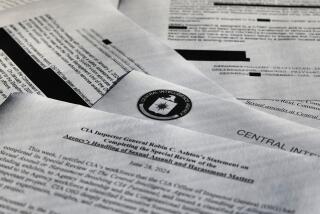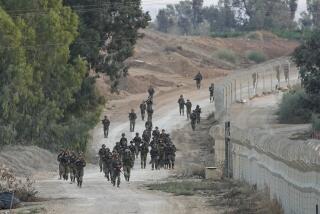The CIA’s assassination puzzle
- Share via
WASHINGTON — In movies, the CIA has so many prolifically lethal assassins roaming the world that the main problem often seems to be reining them in.
But details that spilled out this week about a real CIA assassination program indicate that when the plotting is being done by spies instead of screenwriters, the obstacles are not so easy to surmount.
According to current and former U.S. intelligence officials, the CIA spent seven years trying to assemble teams capable of killing the world’s most wanted terrorists but could never find a formula that worked.
The struggles came during a period in which the agency had been given unprecedented authority and resources, and a cause -- responding to the Sept. 11 attacks -- with broad public support.
But officials could not solve daunting logistical problems, including how to get teams close to their targets while keeping U.S. involvement secret and being able to extract them safely if they succeeded in killing a terrorist.
In interviews, current and former U.S. intelligence officials said the aim of the effort was broader than has been described in newspaper accounts this week.
In particular, officials said, ambitions for the program expanded to include creating teams that were made up not only of CIA personnel but counterparts from other countries, presumably Pakistan; and to be capable not just of killing high-value targets but also executing raids and other operations to gather evidence and intelligence that might lead to elusive Al Qaeda leaders Osama bin Laden and Ayman Zawahiri.
Former officials said support for the program persisted in recent years largely because it could compensate for a crucial shortcoming in the ongoing campaign of Predator strikes. The drones had emerged as a potent weapon against Al Qaeda in Pakistan but had failed to bring the agency closer to Bin Laden.
“The bottom line is that you’ve still got No. 1 and No. 2 out there,” one former high-ranking U.S. intelligence official said. “If all you do is blow stuff up and burn stuff up, you never get information that could lead you to the prize.”
As a result, CIA leaders continued to pursue the idea of elite paramilitary teams that could mount lethal operations on short notice but also quietly capture lower-ranking Al Qaeda members and raid sites struck by Predator missiles to gather any intelligence material left behind.
“If I can just get in there and get information off the ground, I might find one piece of information that’s going to lead me to the prize,” the former official said.
The broader dimensions of the program may account for why some lawmakers, particularly Republicans, have been critical of CIA Director Leon E. Panetta’s decision last month to kill it.
House Democrats, angry that the program was kept secret from Congress, at least partially at the urging of former Vice President Dick Cheney, have threatened an investigation.
Lawmakers on Wednesday continued sparring over Cheney’s role and whether Congress had been properly briefed.
The CIA said the program was never of substantial value to U.S. efforts.
“The program [Panetta] killed was never fully operational and never took a single terrorist off the battlefield,” said George Little, a CIA spokesman. “We’ve had a string of successes against Al Qaeda and other terrorist groups, and that program didn’t contribute to any of them.”
The broader objectives of the program may also help to explain why top counter-terrorism officials saw a need for the CIA to develop its own elite paramilitary teams, rather than relying on U.S. military special operations troops deployed across Afghanistan.
Former intelligence officials said there were intermittent discussions about having special operations troops assigned to the CIA as part of the program, but it was not clear how far those plans progressed.
A second former official with extensive knowledge of the CIA effort said it was seen as crucial that the units reside within the CIA so that the U.S. government would be able to deny involvement if a team were exposed or captured.
Special operations forces routinely carry out clandestine missions, but unlike their CIA counterparts they operate with the expectation that their ties to the U.S. government will not be denied if the mission breaks down.
“Keeping activities like this secret is the biggest challenge,” said the second former U.S. intelligence official.
The vulnerability of being far removed from U.S. protection was seen as another major barrier to the success of the program.
Even if an assassination team were deployed and succeeded in killing a senior Al Qaeda figure, “what happens to the shooter?” said Mark Lowenthal, a former senior CIA official. “We don’t send people on suicide missions. I’m sure they were troubled by how to get the guy out of there.”
In its initial conception, in the aftermath of the Sept. 11 attacks, the CIA program was seen mainly as an effort to assemble teams capable of carrying out targeted killings. But officials have said that it went through multiple “iterations.”
Most recently, the program’s focus had shifted toward intelligence collection, officials said, the latest in a series of efforts toward the end of the George W. Bush administration to find Bin Laden.
In that respect, some officials thought the program could replicate on a small scale the successful formula that the U.S. military had employed as part of the “surge” in Iraq, carrying out raids, exploiting the information gathered, and launching follow-up operations in swift succession.
However, different objectives brought different challenges, officials said, including how to get the right mix of personnel that could operate in the badlands of Pakistan without being captured or exposed.
Former officials declined to say whether the CIA had ever held discussions with Pakistan about setting up hybrid teams with members of the Pakistani military or its main spy service, Inter-Services Intelligence. But one former official said that few officials thought the initiative could succeed solely with U.S. personnel.
“If you’re born in Kansas, you’re always from Kansas,” the former official said. “I don’t care you long you grow your beard, you’re still from Kansas.”
The CIA has sought to carry out assassinations at various times in its history, most notably during the 1960s when it launched a series of botched attempts to kill Cuban dictator Fidel Castro.
The agency has traditionally had paramilitary capabilities as part of its Special Activities Division, which swelled in size after the Sept. 11 attacks and is made up mainly of former members of U.S. military special operations forces.
But carrying out close-range killings “is something they don’t really have a capacity for,” said a former senior CIA official. “There really isn’t Jason Bourne walking around doing stuff like this. The paramilitary guys are mostly retired forces; they’re more for training and working with the Kurds (an ethnic group in northern Iraq) and things like that.”
The commission that investigated the Sept. 11 attacks cited a series of botched attempts to kill Bin Laden in the late 1990s. The CIA’s struggles with the secret program show that “the practical obstacles of setting this up are formidable,” said Philip Zelikow, who was staff director of the commission.
Citing the contrast with depictions in Hollywood, Zelikow said the agency’s efforts served as “one of the more spectacular demonstrations of the real world versus the imagined world of government omnipotence.”
--
More to Read
Sign up for Essential California
The most important California stories and recommendations in your inbox every morning.
You may occasionally receive promotional content from the Los Angeles Times.










